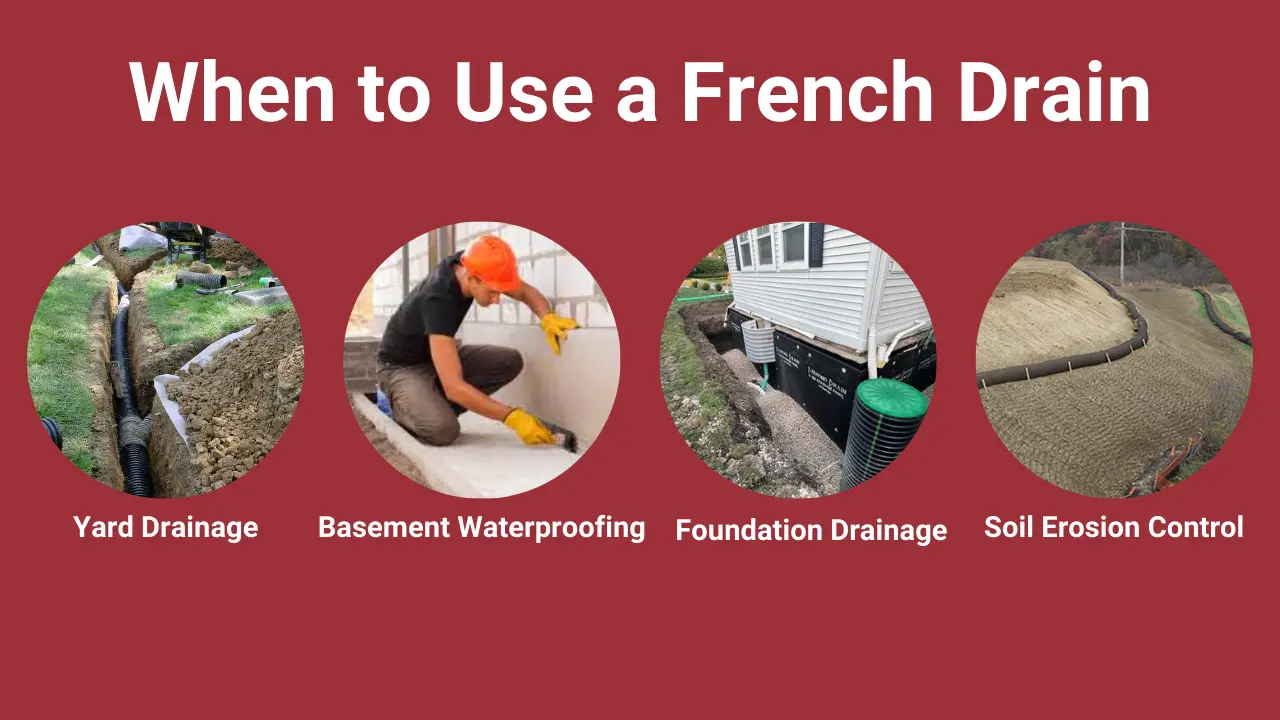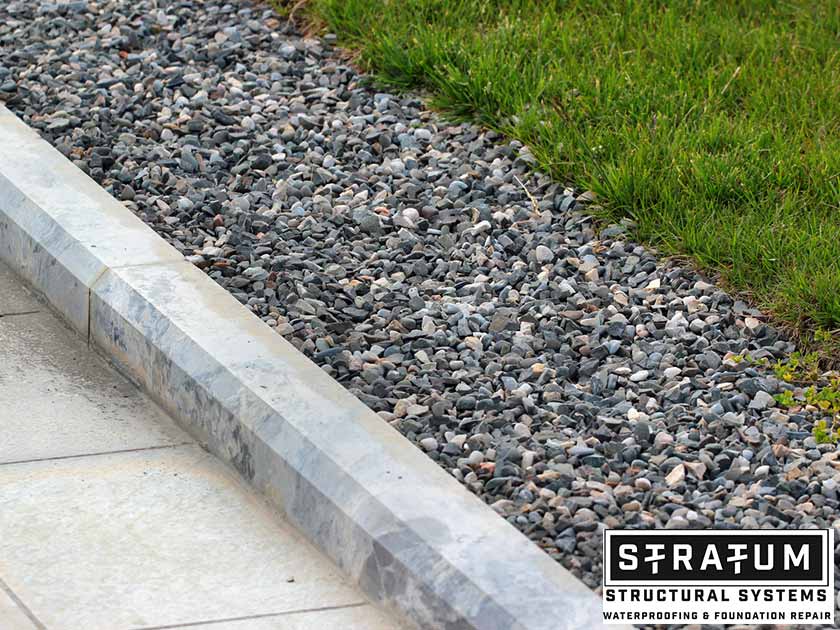Complete Guide About the Portland French Drain Process
Complete Guide About the Portland French Drain Process
Blog Article
The Important Guide to Maintaining Your French Drain for Long-Lasting Efficiency
Keeping your French drainpipe is crucial to its effectiveness and your residential or commercial property's protection. Regular checks can save you from expensive repairs and water damages. You'll desire to understand what indications to search for and how frequently to examine your system. And also, recognizing the cleansing process can make a significant difference. Let's discover the crucial steps for guaranteeing your drain functions well for years to come.
Comprehending the Function of a French Drainpipe
A French drain is an important component in handling water around your home. It routes excess water far from your structure, stopping flooding and damage. When hefty rain drops, the drainpipe collects water via a perforated pipe hidden in gravel. This system allows water to stream freely, lowering pressure on your cellar walls and minimizing the threat of leaks.You may ask yourself exactly how it works in technique. As water saturates the dirt, gravity pulls it towards the drain. The perforated pipeline captures this water, moving it to an assigned drainage location or storm sewage system. This procedure keeps your backyard dry and protects your home's architectural integrity.Understanding how a French drainpipe features is essential to appreciating its significance. By effectively carrying water away, it helps keep a completely dry and safe living setting. So, maintaining your French drainpipe in leading condition guarantees you avoid pricey fixings down the line.
Routine Inspections: What to Look For
When you're evaluating your French drain, beginning by looking for any type of obstructions that may be obstructing water flow. Pay focus to signs of surface erosion around the drain, as this can indicate prospective concerns. Regular assessments will help keep your water drainage system working successfully.
Blocked Drainpipe Analysis
Exactly how can you inform if your French drain is clogged? First, look for water pooling in your backyard, specifically after hefty rain. That's a red flag if you observe locations where water collects rather of draining pipes. You ought to also inspect the drainpipe electrical outlet; if water isn't spurting as it should, there's likely an obstruction. Pay attention for unusual gurgling noises, which can show trapped air. Furthermore, evaluate the drainpipe's surface for any vegetation development, as origins can clog the system and infiltrate. If you smell stuffy smells, it can aim to stationary water created by an obstruction. Routinely reviewing these indicators can help you maintain your French drain successfully and stop expensive repair work.
Surface Area Disintegration Examine

Cleansing Your French Drain: Step-by-Step Overview
Cleaning your French drainpipe is important for maintaining it working correctly. You'll need some certain tools and a clear procedure to ensure whatever runs efficiently. Let's stroll with the actions and ideas for maintaining your drainpipe efficiently.
Devices You'll Need
To take on the task of cleansing your French drain successfully, you'll want to collect a few essential devices. Grab a sturdy set of handwear covers to shield your hands from particles and sharp items. A tiny shovel or trowel will certainly assist you eliminate dust or obstructions around the drain. For removing the inside, a plumbing technician's serpent or a high-pressure water nozzle can be unbelievably valuable. You'll additionally require a container for gathering any type of debris you take out. Finally, having a garden hose on hand will make it less complicated to wash out the drainpipe and ensure it's streaming smoothly. With these devices prepared, you'll be established for an extensive cleansing session!
Cleaning Up Process Actions
Beginning by reviewing the area around your French drain for any kind of noticeable debris or blockages. Get rid of leaves, branches, or dirt that might obstruct water flow. Next off, inspect the inlet and outlet locations; clear any blockages to ensure proper drainage. Make use of a garden hose to purge the drain, routing water into the inlet. This helps displace any accumulated sludge or debris. Consider making use navigate to this site of a plumbing technician's snake to damage them up if you observe persistent clogs. After cleansing, examine the crushed rock around the drain; restore it if it's washed away. Finally, validate the drainpipe covers are intact and securely in position to avoid particles from entering. Routine cleansing keeps your French drain operating effectively.
Maintenance Regularity Tips
While regular upkeep is crucial for your French drain's durability, recognizing just how frequently to preserve it can make all the distinction. Preferably, you should examine your French drainpipe at the very least two times a year, preferably in spring and autumn. After hefty rains or snowmelt, look for blockages or debris. If you notice any kind of standing water, it's time to clean your drain.In areas with heavy foliage, more regular upkeep-- concerning every 3 months-- might be necessary. Additionally, think about cleaning your French drain after major storms or if you observe water pooling in your lawn. By remaining aggressive, you'll assure your French drainpipe features properly and protects your building from water damage. Regular checks will save you time and money in the future.
Determining Typical Problems and Their Solutions
When you observe water pooling in your lawn or damp areas in your basement, it's important to identify common problems with your French drain and execute effective services. One regular trouble is clogging, commonly triggered by debris like leaves or debris. To repair this, you can make use of a pipes snake or a high-pressure water jet to clear blockages.Another issue may be incorrect slope. If your drainpipe isn't sloped properly, water won't move far from your home. You can adjust the incline by digging and repositioning the drainpipe pipe.Lastly, check for damages or fractures in the drain itself. Replacing the harmed sections is important for peak efficiency if you discover any. By addressing these concerns immediately, you'll help assure that your French drainpipe continues to operate efficiently, shielding your residential or commercial property from water damages and preserving a completely dry, safe setting.
Seasonal Maintenance Tips for Your French Drainpipe
Addressing typical concerns with your French drain is simply the very first step in guaranteeing its lasting efficiency. Seasonal upkeep is important for peak efficiency. In the spring, eliminate leaves and debris that might have built up throughout winter. Look for any type of blockages in the outlet or catch basin, as water requires a clear path to move freely.During summer, check your drainpipe for any indications of moving or resolving soil. Make certain it's still degree and operating properly. As fall methods, tidy out any kind of fallen leaves to avoid obstructions prior to winter arrives.In winter, look for freezing temperature levels. If you live in a cold environment, make certain your drainpipe isn't in danger of freezing. Protecting revealed pipes can aid. Regular checks and timely upkeep can protect against costly repairs and maintain your French drainpipe functioning properly year-round. Remain proactive and delight in comfort understanding your drain system is in good condition!
When to Contact a Specialist
Understanding when to employ an expert can save you time and prevent further damages to your French drainpipe. It's a clear sign that your drainpipe might be clogged or harmed if you observe consistent standing water in your yard. Do not disregard strange smells, as they can suggest sewage back-up or decay, which requires prompt attention.If you discover that your drainpipe isn't working correctly after attempts to tidy or maintain it, it's time to connect for specialist assistance. Additionally, if you're unclear regarding the underlying problems or do not have the needed tools, you can look here working with a professional can offer tranquility of mind.Finally, if your French drainpipe is old or has experienced considerable damage, expert assessment can identify whether repairs or full substitute is required. Trust the specialists to ensure your drainage system functions efficiently for look at these guys several years to find.
Tips for Stopping Future Drain Issues
To maintain your French drainpipe working successfully, consistently checking and preserving it can make all the distinction. Beginning by removing particles, leaves, and dirt from the surface and drainpipe openings. This prevents obstructions that can bring about water backup. Inspect the crushed rock around the drainpipe; if it's compacted or worn down, take into consideration adding fresh gravel to preserve excellent flow.Next, divert water away from your drain by ensuring downspouts and rain gutters are clear and routing water at the very least three feet away from your structure. Consistently inspect for any indications of damages or drooping. If you notice issues, address them immediately.Finally, consider setting up a filter or a catch basin to trap larger particles before it enters the drain. By staying proactive with these suggestions, you'll lessen the danger of future drain issues and maintain your French drain in top shape.
Often Asked Questions
Exactly how Long Does a French Drain Generally Last?
A French drain usually lasts around 30 to 40 years, depending upon the products utilized and maintenance (Portland French Drain). If you stay on top of regular checks, you can extend its lifespan also better
Can I Mount a French Drainpipe Myself?
Yes, you can mount a French drain yourself if you've got the right tools and understanding. Simply make sure to intend meticulously, adhere to neighborhood regulations, and warranty correct drain to avoid future issues.
What Products Are Utilized in a French Drain?
You'll require perforated pipeline, gravel, landscape textile, and a strong drain pipe for your French drainpipe. These materials help reroute water effectively, avoiding flooding and keeping your building secure and dry from water damage.

Is a Permit Required to Install a French Drainpipe?
You'll likely require an authorization to mount a French drain, depending on local regulations. Get in touch with your municipality to assure you follow any kind of needed standards and prevent prospective issues during installation.
What Are the Prices Connected With French Drainpipe Maintenance?
Maintaining a French drainpipe typically sets you back in between $100 and $500 every year. You'll need to think about expenditures for cleansing, repair services, and assessments. Routine maintenance aids stop larger assurances and costs your system functions effectively for many years - Portland French Drain. When you're examining your French drain, begin by checking for any type of clogs that could be obstructing water flow. By remaining positive, you'll guarantee your French drainpipe functions properly and secures your residential property from water damage. When you notice water merging in your lawn or damp places in your cellar, it's important to identify typical issues with your French drainpipe and execute reliable options. You can adjust the incline by digging and repositioning the drainpipe pipe.Lastly, check for damage or splits in the drain itself. Examine the gravel around the drainpipe; if it's compacted or deteriorated, take into consideration adding fresh crushed rock to keep ideal flow.Next, draw away water away from your drain by making certain downspouts and seamless gutters are clear and directing water at the very least 3 feet away from your foundation
Report this page